Agentforce, the GenAI Agent by Salesforce

The transport sector, with diesel as the dominant fuel type, is responsible for over 20% of human caused greenhouse gas emissions (GHG) in Europe[i], coming in second place only after the energy generating sector (resp. 31%) as a major contributor to global warming.
The transport sector, with diesel as the dominant fuel type, is responsible for over 20% of human caused greenhouse gas emissions (GHG) in Europe[i], coming in second place only after the energy generating sector (resp. 31%) as a major contributor to global warming. Road transport is responsible for the largest share of transport GHG (>70%) emissions[ii], and whereas heavy-duty transport vehicles represent only 3% of the fleet, they account for approximately 25% of emissions from road transport. Additionally, the emissions of particulate matter and NOx from mostly diesel-powered lorries are a major source of air pollution in urban areas or industrial zones. In perspective of the continued predicted growth of transport volumes, the sector faces an enormous challenge in meeting the EU’s emission reduction requirements of -30% by 2030 and -60% by 2050 (compared to 1990 levels). A key element in reducing GHG emissions will be the shift to less environmentally strenuous sources of power for the road freight sector. There are many alternative concepts to replace the polluting diesel fuel, some of which are already available for industry adaptation, and others which are still in early development stage.
Each one of these alternatives has its own advantages and disadvantages, making them suitable for different applications under different conditions. This article assesses the viability of these alternative technologies for the use in road freight transport, with a main focus on External Electric Power Supply solutions.
The range of alternative solutions can be categorized as follows: There is a first distinction between On-Board Power Storage solutions and systems that use External Electric Power Supply. The on-board storage systems can be further subdivided into alternative fuel systems which run on fuels such as biodiesel or gas (LNG: liquid natural gas; CNG: compressed natural gas; ethanol; bio-diesel) and electricity storage systems using batteries or hydrogen fuel cells. The External Electrical Power Supply systems for road transport in turn consist of inductive (i.e. contactless) and conductive (i.e. mechanical contact) systems.
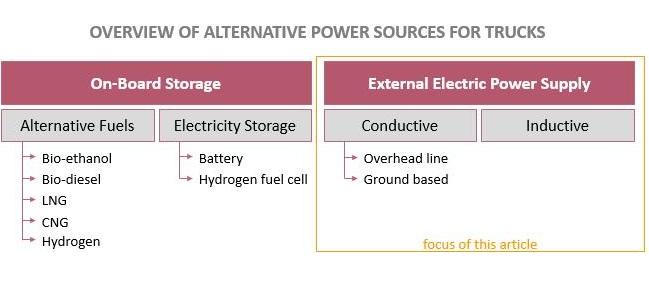
Alternative fuel sources are those fuel sources used in internal combustion engines (ICE) that are not based on crude oil (i.e. petrol and diesel), but on alternatives such as bio-ethanol, bio-diesel, gas or hydrogen. Each one of these alternatives has advantages compared to diesel and petrol in the form of a lower carbon footprint, reduced emissions of air polluting particles, more stable fuel prices and less noisy vehicles. Each one of them however also has its own drawbacks, such as competition with food production (i.e. increased food prices and reduced food availability due to their origination from organic material such as corn or sugar cane) in the case of bio-ethanol and -diesel, limited power in the case of the gas solutions, and safety concerns in fuelling or storage in the case of hydrogen. They therefore present a first promising alternative to diesel, but due to the various disadvantages that still need to be resolved (some of which cannot be resolved because they are inherent to the fuel type), along with a range of other factors, they have not yet been widely adapted in heavy road freight transport.
On board electricity storage systems present another alternative, whether in the form of battery or hydrogen fuel cell powered vehicles. In comparison to the previously discussed alternative fuels, these solutions do not require an ICE and have the advantage of being potentially free of any polluting or GHG emissions. Whether or not they are fully carbon free of course depends on the electricity origin. They also have the advantage of completely eliminating any noise pollution caused by the vehicle. The first type of on-board electricity storage system used battery power. Battery powered electric cars are currently on the verge of a major breakthrough, with GM recently having released its first high-performance electric model for a broad audience, and many more to follow suit.[iii] Major challenges however remain, most notably the limited driving range, long charging times, heavy weight and volumes of the batteries, and the elevated cost as compared to regular combustion engine models. The electric market is still relatively immature though, and the heavy investments being made in its development mean that big improvements can be expected in the industry. Still, for now, the application of battery powered vehicles in long-distance cargo transport is extremely limited. Nevertheless, companies such as Tesla and VDL recently made promising announcements regarding the development of fully electric trucks that store their energy in batteries with a range of about 100km. These trucks are expected by the end of 2017, early 2018. [iv],[v] BMW already presented a similar 40-ton lorry mid-2015. Therefore, it can be expected that battery-powered road freight transport will mostly be adapted for high-intensity short-distance transport in the near future. Another on-board electricity storage system uses hydrogen fuel cells, which unite the advantages of diesel (i.e. long range, high performance and short refill times) with those of electric vehicles (i.e. zero emissions, smooth driving and instant torque). Although there are some experiments of this technology in logistics (e.g. hydrogen buses used by De Lijn, forklifts used by Colruyt, hydrogen lorries used by La Poste in France), the breakthrough for heavy-duty trucks seems to be far off.[vi],[vii] This is mostly due to the limited life time of fuel cells, the before mentioned safety concerns, and the obvious lack of refuelling stations. As these are factors that can be improved, it can be expected that this technology will break through in the long term, but currently its application stays rather limited.
A detailed overview and discussion on the on-board storage solutions for road transport is presented in a January 2016 Sia Partners Insight study.[viii]
Another approach to making road freight transport more sustainable is the implementation of an electric road system (ERS) which provides electric power to trucks equipped with an electromotor by the use of an external power source. More specifically, technology has been developed for conductive powering of electrified trucks through overhead or ground-based contact lines and for contactless powering by means of induction. In these approaches, hybrid trucks are used that comprise of an electromotor taking electricity from an outside source, as well as an on-board power source (fuel or electricity based) to ensure a continuous source of power for the trucks when they are not connected to the external grid. In case the hybrid truck is equipped with a battery, this can then be charged by the ERS and through regenerative braking.
Hybrid lorries getting their power from an ERS combine many of the advantages of independent electric vehicles with those of rail transport. First of all, they result in a significant reduction of GHG emissions (depending on the energy sourcing there is potential for zero-emissions), and eliminate polluting exhaust particles, making them a clear green alternative. Secondly, the electromotors can operate silently, reducing noise pollution of heavy freight transport. Thirdly, compared to the independent electric vehicles, they do not face the many battery related problems that are holding back the development of the electric vehicle industry for heavy freight in long haulage: limited driving range, high cost of the batteries, heavy weight and size of the batteries (which reduces the available space for cargo), long reload times, questionable future availability of crucial materials, etc. In addition, the outside power supply and electromotor combination has an energy efficiency superior to that of both combustion engine and battery powered vehicles, meaning that less energy is needed for the same tonne-kilometres (though this exact efficiency depends on the specific technology being used). The well-to-wheel efficiency (i.e. the total efficiency from the initial energy generation to the kinetic movement of the vehicle) of an ICE is about 35 to 40% and around 60% in the case of battery powered vehicles, while that of the different ERS varies between 70 to 80%.[ix],[x] This economic advantage is further reinforced by the fact that electricity is cheaper than combustion fuels like diesel, and fact that the lifetime of an electromotor vehicle exceeds that of a traditional engine vehicle. On the other hand, in contrast to rail transport, the hybrid technology used in ERS offers the vehicles the same flexibility that is so much valued in road transport, allowing them to connect and disconnect to the system as needed. Lorries connected to an ERS can be just as easy to drive as regular trucks, and require little or no behavioural changes from the driver.
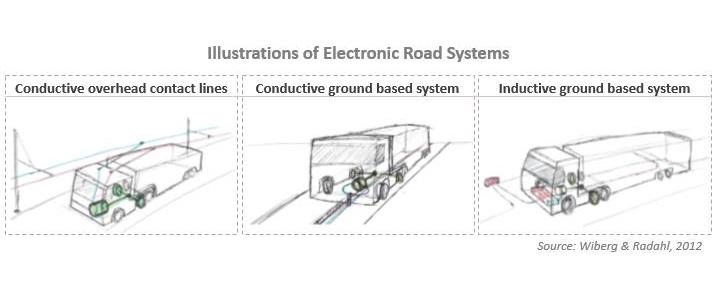
The first approach to ERS consists of an overhead conductive contact line (catenary) infrastructure and trucks equipped with an active current collector (pantograph), thus using proven technologies from rail transport modified for lorries. The necessary transport infrastructure needed to operate conductive overhead truck transport consists of various elements. The first are the different substations that are connected to the grid that provide a constant transfer of electricity to the trucks through the overhead contact lines and the pantograph. Second is the catenary infrastructure that consists of the two-pole overhead line system providing grounding, and the electricity pylons along the road to span these overhead lines at a height of over 5 metres (which is necessary for safety reasons). The last important element is the truck itself that is equipped with an active pantograph, an electromotor, and a secondary power source for “off-grid” driving. In this conductive overhead system, trucks do not follow a strictly predetermined path and have the flexibility to leave and join the electrified road. To ensure this flexibility, the intelligent pantograph is a key element of the system. The smart pantograph is able to sense the presence of the electrification infrastructure and automatically move horizontally and vertically in order to make or release contact with the overhead lines (this process currently works for speeds up to 90km/h).[xi] If there is no conductive overhead line available, the pantograph folds down on the truck’s cabin.
There are several specific benefits attributed to the conductive overhead line system. For starters, this technology performs best in terms of energy efficiency, with the efficiency in transfer from the grid to the electromotor in this system standing at around 96%. The overhead system also has the advantage of being easy and fast to integrate into existing infrastructure.
One disadvantage of the overhead line technology compared to the ground bases system is that it is subject to minimum height requirements. This is due to safety regulations regarding the high-voltage power lines, and the fact that it cannot obstruct any vehicles. This implies that the technology is only suitable for high vehicles such as trucks and buses, meaning that the infrastructure development cost for this system – between € 1 and 3 million per double-sided road km [xii] – could not be put to use for the incorporation of passenger cars. Second is the visual impact of these systems, which is not present in the ground-bases solutions. The overhead line system is also the most vulnerable to damages and safety hazards caused by severe weather conditions like storms.
Though still in infancy stage, there are some early development examples of this technology which have been conducted or are still in process. Siemens developed an intelligent pantograph and catenary system that is being used in a range of eHighway projects to test the viability of the technology.[xiii] A first ENUBA 1 research project, funded by the German government in 2012, included testing the eHighway’s technical feasibility on a specially built test track in the north of Berlin, as well as testing the expected economic and CO2-reduction benefits. A follow up project, ENUBA 2, is currently being conducted and focusses on optimizing the integration of the drive system and pantograph into the vehicle, on the necessary traffic control systems, and on automation and control mechanisms. These projects were the first big step in proving the technical feasibility and the expected benefits of the technology in road freight transport. In addition to the ENUBA projects, two public road demonstration projects are now in progress in California and Sweden. In June 2016 a two-kilometre single-lane stretch of the E16 north of Stockholm was supplied with the necessary eHighway infrastructure. A two-year trial with hybrid diesel trucks manufactured by Scania will be conducted in order to determine if the system is suitable for future commercial use and further deployment. In California a similar project will be rolled out on public roads between the twin ports of L.A. and Long Beach with trucks from the Volvo Group in 2017.
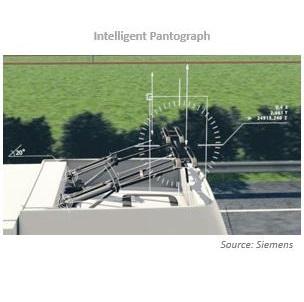
Conductive ground-based system
A second approach to electrifying road freight is an ERS that powers trucks conductively from rails in the road, meaning that there is still a physical connection between the vehicle and the grid. This technology, like the catenary system, is not entirely new either, and is currently being adapted for the use by lorries by companies like Alstom and Elways. The rail is segmented into smaller parts that are electrified only when a suitable vehicle drives over the segment, in order to increase the safety of the system. Vehicles that want to make use of the system need to be equipped with a smart pickup that locks onto the rail and enables the electric power transfer. This pickup, similar to the intelligent pantograph, has to be able to sense the rail, detach and attach automatically, and follow the rail even when the vehicle is not in perfect alignment with the rail, though assisted driving will also be of importance in ensuring this alignment when this technology hits public roads.
Some advantages the ground-based solution has over the overhead ERS are the possibility for cars – and not only trucks or buses – to make use of it. Another important aspect that would favour the ground-based system is the lower roadway infrastructure development cost, totalling between € 250 thousand and 1 million per two-sided road km[xiv]). Also, compared to the overhead system, the ground based solution has a minimal visual impact. This system has an efficiency of about 95% in transferring power from the grid to the electromotor, which is similar to that of the overhead system.
One of the main drawbacks that need to be addressed in this particular application concerns safety. As the rail is embedded in the road, it is prone to human contact, meaning that there is the risk of people getting electrified when touching it. This safety concern can be partially mitigated by placing the rail a couple of centimetres inside the road pavement, and by segmenting the rail and only electrifying those parts with a moving vehicle on it. Another drawback compared to the overhead system is the stronger influence of the weather on its performance. Although the system is designed to rinse small items such as snow and rain, extra efforts might be needed to clear the rail if severe weather conditions occur.
In Arlanda, Sweden a segmented test track was built to assess the feasibility of the conductive ground-based ERS, with technology developed by Elways. The first testing phase focussed mainly on safety verification and on the electricity transfer quality in various weather conditions. A second phase of the project placed an e-road from Arlanda airport to a logistics centre 10 km further in Rosersberg and focuses on the necessary modifications needed for a full public road roll-out. Alstom and Volvo also developed an alternative solution to in-ground conductive charging that has been tested on a 400m track outside Gothenburg.
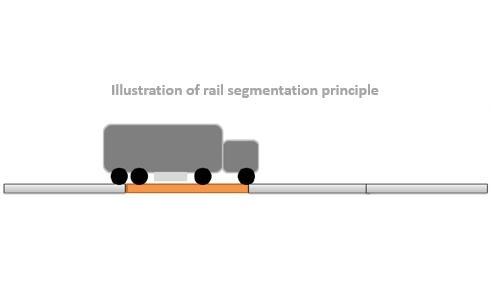
Inductive ground-based system
A last approach to the electrification of road transport is the inductive ERS. In contrast to the conductive systems, in this case there is no mechanical contact between the power source and the vehicle. The system uses an alternative current transformer and a conductor inside the road to generate a magnetic field, which can be converted into electrical current by a vehicle equipped with an inductive pickup. There are already some examples of the use of this technology with buses in urban areas, and adaptations for road freight transport are now in development.
The main advantages of the inductive system arise from the fact that it is embedded inside of the asphalt and that there is no mechanical contact between the vehicle and the grid. This means that the power transfer infrastructure is not visible and does not suffer from wear due to contact or due to exposure to different weather conditions.
This advantage is nevertheless also the source of the system’s greatest disadvantages. In order to transfer power to the vehicles, the system needs to generate a magnetic field that can be harmful to humans, electronics and possibly the goods transported. To mitigate these effects, the inductive ERS has to be segmented similarly to the conductive rail-in-road system and only emit a magnetic field locally when adapted cars of a minimum speed are detected, as well as have safety shields that block magnetic radiation on-board the vehicles. The energy transfer efficiency of this technology is also inferior to that of the conductive system, and more volatile because it depends on the size of the air gap between the vehicle and the road, and the alignment of the vehicle with the conductor in the road. An air gap of 15-20 centimetres is expected to result in a transfer efficiency of about 80% to 85%, if the vehicle’s pickup area is located exactly above the conductor in the road. Such a small air gap increases the risk of damage to the truck due to common road debris. In addition, this system is significantly costlier than the conductive alternatives, at € 3 to 5 million per two-way kilometre of road.[xv]
The inductive system has already been tested out by Bombardier for road freight transport based on its Primove technology on test tracks and on hybrid buses in Södertälje Sweden, Lommel Belgium and Augsburg Germany, where tests were conducted to examine the technology in uphill conditions, different weather conditions, acceleration and full speed operation, and get a proper insight in the cost structure. Additional wireless electric vehicle charging technology exists from Qualcomm, which has developed inductive charging solutions for both parked and moving vehicles with its Qualcomm Halo technology.
So why hasn’t the industry adapted ERS…?
The electrification of road freight transport with ERS technologies thus presents a viable option for reducing the environmental impact of cargo transport and improving its energy efficiency (though the environmental impact of the infrastructure development cannot be underestimated, with increased need for components such as metallic parts, cables, etc.). ERS transport is able to operate mostly noise-free and does away with the battery related issues that independent electric vehicles face, while maintaining transport flexibility. By running on electricity instead of combustion fuels, firms could additionally save money and have a more stable variable costing structure, and gas or petroleum importing countries could reduce their dependency on resource imports. Because of the decreased need for battery power in vehicles mostly connected to the grid, the additional costs needed for adapting a lorry with the necessary hybrid and ERS technology are also not disproportionally high [xvi], [xvii].
The various economic and ecologic benefits detailed above, as well as the technical feasibility, have been proven by several trial projects both on test tracks and on public roads in different parts of the world, instituted by different players in the industry. Yet, despite the proven interest in the technologies and the positive results, these projects seem to stay stuck in R&D phase, while industry wide adaptation is held off.
The reasons for this are of course multiple and very complex, relating to several downsides and challenges of these technologies. One of the main ones is the high fixed (and upfront) cost needed to provide the necessary infrastructure, the maintenance costs, and the need for an industry wide adaptation of one standard. In order for any player to invest in ERS-adapted hybrid trucks, a sufficiently widespread network would have to be in place to satisfy his routing needs. However, the uncertain industry adaption and complex stakeholder structure have so far held off any large-scale infrastructure development, presenting a clear “chicken and egg” issue.
Additionally, ERS transport is a more closed loop system than what has been the case for conventional transportation with its open socio-technological system comprising of different actors, and thus the role of the state is much more pronounced in the case of ERS for widespread implementation. With ERS, all the different subsystems are more tightly linked together, and the various technology standards need to be adapted to each other, while still stimulating private sector innovation. This means that as opposed to the more fragmented conventional road transport market, the ERS market would need a more centralized investment and coordination structure, with a few players taking on the heavy burden of financing the development of the necessary infrastructure, along with more cooperation between the different industry players. Though this presents a challenge, the fuel savings that can be attained by the vehicles making use of the system means that there is a viable business case for private sector investment in the infrastructure, and the positive environmental impact of the system – as well as long term profits – warrants investment by the state.
The interlinkage of the different players within the vertical is further complicated by the need for several new industry specific services and applications. One of these concerns the payment structure linked to taking electricity “on the go” from a grid instead of filling up at an individual station.
Another challenge ERS face concerns the safety of the system. Each specific technology has its own proprietary safety related issues which need to be resolved, but given the widespread development of rail transport despite similar risks, this should not be the hurdle that cannot be passed.
Finally, for the technology to really become standard practice, additional tests are still needed that prove the viability of the systems in real life scenarios (e.g. under full utilization, wear and tear of repeated usage, etc.).
Reducing the road transport sector’s ecological footprint while satisfying consumer and industry demands will surely not happen with one all-encompassing solution. Rather, a combination of several alternatives will be needed, each adapted to a specific transport segment, but at the same time a limitation on the amount of alternative technologies is needed to allow the development of a few key standards and scale economies to arise.
Though there are clearly still some challenges to be overcome and large-scale public trials to be executed before ERS can become one of these industry standards, it does present a promising alternative and definitely shows future potential for heavy-duty freight transport. The conductive solutions are currently technologically more mature, whereas the inductive technology still faces a longer development curve. Possibly, by the time the technological advance in the inductive technology will have succeeded in raising efficiency over larger air gaps, bringing down costs, and reducing any negative impact of the magnetic radiation, it might already be too late and network economies working in favour of the conductive technology will have created an impenetrable market.
In the short-term, the overhead conductive catenary system shows the highest potential for drayage (i.e. high-frequency short-distance transport) in for example industrial zones (e.g. ports), connections between freight transport centres and harbours, and for mine transport (i.e. connecting pits and mines to transit or storage locations). These are characterised by short, frequently used fixed routes. The overhead conductive system is preferred in these cases for several reasons. First, it presents a lower electrocution hazard in zones where slow transport is not uncommon and mixed with pedestrian traffic, and where interference with a ground-based infrastructure might pose problem during loading and unloading. Strong weather resistance of the infrastructure will however have to be attained in order for this safety argument to stay valid. In addition, the visibility issue of the system is not a problem in these types of zones. Furthermore, routes do not have to be closed off entirely when building the catenary infrastructure, and thus the implementation of this system would not hinder the industrial activities. Also, the overhead system would be least prone to damages from heavy industrial vehicles and transport spills (though flammable cargo would have to protected and handled with extra care). Lastly, since the development of the power infrastructure would be within a confined space, it would allow proprietary investment in the development of the infrastructure by those parties who will make us of it.
In the medium-term, electrified long-haul freight transport also shows promise. This segment represents more than 30% of all GHG emissions by heavy-duty vehicles.[xviii] Though covering long distances, electrifying long-haul routes would not be an out-of-reach task, as most of this transport is concentrated on a few key highways. For example, in Germany 60% of all heavy-duty vehicle emissions occur on only 2% of the total road network.[xix] The conductive ground based technology provides the best solution for these heavily trafficked routes, for several reasons. One obvious argument is that it would allow the high amount of passenger cars travelling on these highways to also benefit from it. It is also the solution with the lowest cost per km, which is a key argument when considering the distances to be covered. Furthermore, the electrocution hazard of the technology is not as much an issue on highways where there is no pedestrian traffic. Nor do heavy weather conditions like snow affect highways as much as back routes. In order for this evolution to place however, studies will need to be conducted on regional and national levels to determine the necessary to-be electrified roads that will allow enough industry players to satisfy their off-grid routing needs with the hybrid technologies. Also, given the high cost of covering these high distances with the necessary infrastructure, deep pockets will be required to make this happen, either from the public or the private sector, or a combination of both.
Electrified roads for (last-mile) distribution and inner-city freight transport do not seem to have advantages that outweigh the downsides and challenges presented by it in the foreseeable future. Though this could change in the long run, battery performance of stand-alone electric vehicles, along with other industry innovations, will likely have made much headway by then for these applications, meaning that there might no longer be a need for ERS.
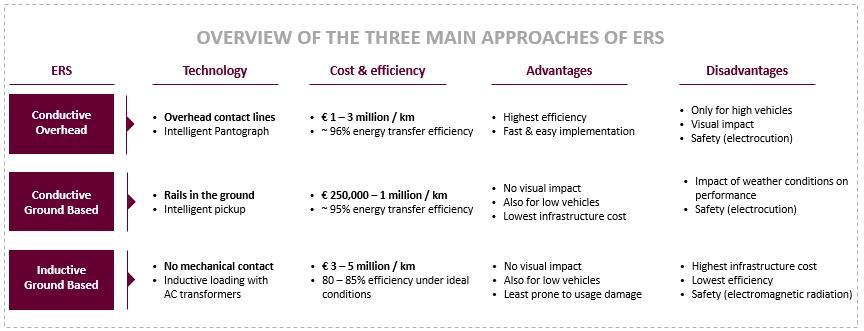
In conclusion, it is recommended for developers of the main technologies present in the three different ERS systems to cooperate for the creation of industry standards, so that they can be brought to market – potentially under joint-venture type executions. This needs to happen fast, so that the other dependent technologies can be guided in their development and know what specifics to focus on. Strong partnerships with truck developers will also be necessary, so that high-performance hybrid trucks can be created by all major players in the lorry market through a modular approach, with the necessary incorporated ERS technology. Governments will need to set an exemplary role in stimulating the development of these technologies by showing political will, providing favourable legal frameworks, sponsoring market studies to determine infrastructure and safety provision needs, backing large-scale public trials, and putting forth the necessary funds for development, or allow deep pocketed private players to step in and take the winnings.
SOURCES:
[i] Eurostat, 2016, Greenhouse gas emission statistics.
[ii] European Commission, 2016, Reducing Emissions from Transport, http://ec.europa.eu/clima/policies/transport/index_en.htm.
[iii] Wired, 2016, How GM beat Tesla to the first true mass-market electric car.
[iv] The Telegraph, 2016, Elon Musk sets sights on Tesla buses and trucks as he says electric vehicles are 'not some silly hippy thing'
[v] NRC, 2016, Elektrisch rijden : Ook VDL gaat elektrische vrachtwagens maken
[vi] VMX, 2015, Duurzamere bussen voor De Lijn.
[vii] Logistiek.be, 2012, Colruyt Halle gaat voor groene waterstof heftrucks.
[viii] Sia Partners, 2016, Alternative fuels for road transport.
[ix] SIEMENS, 2015, Electric roads for heavy duty vehicles.
[x] Akerman, P., Birkner, M., Lehmann, M., 2016, Demonstrating a System for Efficient and Sustainable Road Freight Based on Dynamic Power Supply.
[xi] SIEMENS, 2015, Electric roads for heavy duty vehicles.
[xii] Swedish Energy Agency, 2013, Slide-In Electric Road System
[xiii] Siemens, 2016, Electrification of road freight transport.
[xiv] Lykogianni, M., G., Österlind, M., 2014, An Electrified Road Future: A feasibility study of Electric Road Systems (ERS) for the logistic sector in Sweden, KTH Royal Institute of Technology.
[xv] Swedish Energy Agency, 2013, Slide-In Electric Road System.
[xvi] Gladstein, Neandros & Associates, 2012, Zero-Emission Catenary Hybrid Truck Market Study.
[xvii] Swedish Energy Agency, 2013, Slide-In Electric Road System.
[xviii] Andersson, S., Edfeld, E., 2013, Electric road systems for trucks, KTH School of Industrial Engineering and Management.
[xix] SIEMENS, 2015, Electric roads for heavy duty vehicles.